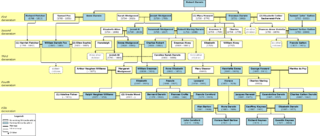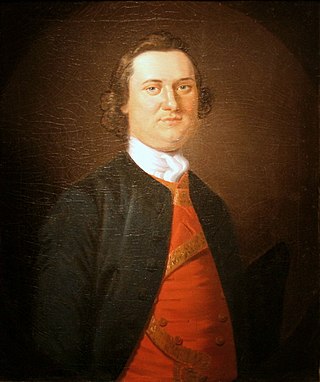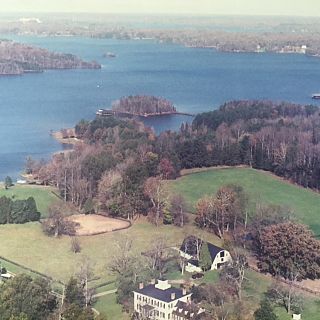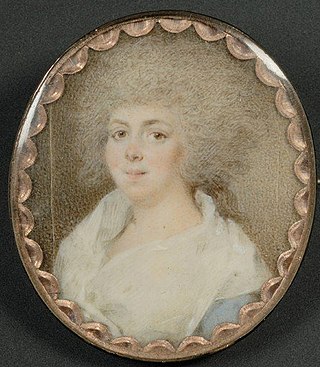This article needs additional citations for verification .(January 2024) |
George Kennedy (1799-1870) was a Canadian businessman. Georgetown, Ontario is named in his honour.
This article needs additional citations for verification .(January 2024) |
George Kennedy (1799-1870) was a Canadian businessman. Georgetown, Ontario is named in his honour.
Kennedy was born at Snyder's Mills (St. Ann). His father was John Kennedy (1761-1847) and his mother was Charity (née Wurtz) (1761-1800). John was a teacher, a job he had trained for years before in Sussex, New Jersey. Charity ran the household.
His siblings include: John (1787-1874), Elizabeth (1788-1842), Ann (1790-1797), Charles (1792-1854), and Morris (1794-1870).
After the death of his mother (Charity), his father remarried, this time to Barbara (née Slough) (1773-1849). Barbara and John had eight more children.
Kennedy served with the British during the War of 1812. In 1819, five Kennedy brothers claimed land in Halton County, Ontario. George, Morris, Charles, Samuel and John settled in an area that is now in Georgetown, Ontario in 1823. Several years later, their brother-in-law, Benajah Williams arrived and settled in the area that later became the community of Glen Williams. [1]
George dammed the Silver Creek property in the early 1820s to power a sawmill, and later a gristmill and foundry and then a woolen mill; a small settlement formed around the mills, often called "Hungry Hollow". [2] In the 1850s, he subdivided his land into small lots for sale to new settlers. [3]
George married Sarah Bedford (1798-1875) in 1821. They had nine children: Charity (c1822), Sarah (c1823), Harriet (1824) - the first child born in Georgetown, George Couse (1826), Emery (1827), Sarah Ann (c1828?), Louisa (1830), John Corban (1834), and Barbara Elizabeth (1836).
Kennedy's parents were supporters of the King during the American Revolutionary War. After its conclusion in 1783, life became unbearable for the Loyalists who settled in places like Nova Scotia, New Brunswick and Quebec. Niagara District, Upper Canada was the place that John and Charity travelled to with their children. Land was granted to John in Gainsborough Township, Niagara District in 1795.

Georgetown is a large unincorporated community in the town of Halton Hills, Ontario, Canada, in the Regional Municipality of Halton. The town includes several small villages or settlements such as Norval, Limehouse, Stewarttown and Glen Williams near Georgetown and another large population centre, Acton. In 2016, the population of Georgetown was 42,123. It sits on the banks of the Credit River, approximately 40 km west of Toronto, and is part of the Greater Toronto Area. Georgetown was named after entrepreneur George Kennedy who settled in the area in 1821 and built several mills and other businesses.

Oliver Phelps was an American politician. He was early in life a tavern keeper in Granville, Massachusetts. During the Revolution he was Deputy Commissary of the Continental Army and served until the end of the war. After the war ended, he was appointed a judge, was elected to the U.S. House of Representatives, and became a land speculator in western New York state. A depressed real estate market forced him to sell most of his holdings.

The Darwin–Wedgwood family are members of two connected families, each noted for particular prominent 18th-century figures: Erasmus Darwin, a physician and natural philosopher, and Josiah Wedgwood FRS, a noted potter and founder of the eponymous Josiah Wedgwood & Sons pottery company. The Darwin and Wedgwood families were on friendly terms for much of their history and members intermarried, notably Charles Darwin, who married Emma Wedgwood.

Lewis Morris was an American Founding Father, landowner, and developer from Morrisania, New York, presently part of Bronx County. He signed the U.S. Declaration of Independence as a delegate to the Continental Congress from New York.

Molly Brant, also known as Mary Brant, Konwatsi'tsiaienni, and Degonwadonti, was a Mohawk leader in British New York and Upper Canada in the era of the American Revolution. Living in the Province of New York, she was the consort of Sir William Johnson, the British Superintendent of Indian Affairs, with whom she had eight children. Joseph Brant, who became a Mohawk leader and war chief, was her younger brother.

Sarah Scott was an English novelist, translator, social reformer, and member of the Bluestockings. Her most famous work was her utopian novel A Description of Millenium Hall and the Country Adjacent, followed closely by the sequel The History of Sir George Ellison.

Robert Nelles was a businessman and political figure in Upper Canada.

The Randolph family of Virginia is a prominent political family, whose members contributed to the politics of Colonial Virginia and Virginia after statehood. They are descended from the Randolphs of Morton Morrell, Warwickshire, England. The first Randolph in America was Edward Fitz Randolph, who settled in Massachusetts in 1630. His nephew, William Randolph, later came to Virginia as an orphan in 1669. He made his home at Turkey Island along the James River. Because of their numerous progeny, William Randolph and his wife, Mary Isham Randolph, have been referred to as "the Adam and Eve of Virginia". The Randolph family was the wealthiest and most powerful family in 18th-century Virginia.
Thomas Morris was a United States representative from New York and was the son of Founding Father Robert Morris.

The Livingston family of New York is a prominent family that migrated from Ireland to the Dutch Republic, and then to the Province of New York in the 17th century. Descended from the 4th Lord Livingston, its members included signers of the United States Declaration of Independence and the United States Constitution. Several members were Lords of Livingston Manor and Clermont Manor, located along the Hudson River in 18th-century eastern New York.

Jerdone Castle is a plantation located in Bumpass, Louisa County, Virginia, originally established c. 1742. Jerdone Castle is a Virginia Historic Landmark and registered on the U.S. National Register of Historical Places. Originally 1,100 acres (450 ha), much of the plantation's original land is submerged under Lake Anna. The estate currently contains 175 acres (71 ha).

Eleanor Calvert Custis Stuart, born Eleanor Calvert, was a prominent member of the wealthy Calvert family of Maryland. Upon her marriage to John Parke Custis, she became the daughter-in-law of Martha Dandridge Custis Washington and the step-daughter-in-law of George Washington. Her portrait hangs today at Mount Airy Mansion in Rosaryville State Park, Maryland.
William Mason was an American planter and soldier. He was a militiaman in the American Revolutionary War and a prominent Virginia planter. Mason was the third son of George Mason, an American patriot, statesman, and delegate from Virginia to the U.S. Constitutional Convention.

George Calvert Yount, later known by his Spanish name Don Jorge Concepción Yount, was a Californian ranchero, fur trapper, and entrepreneur. Born in North Carolina, he later emigrated to Alta California, where he became a Mexican citizen and acquired substantial property holdings in the Napa Valley, largely due to the influence of his friendship with General Mariano G. Vallejo. The city of Yountville, California is named for him.
Wilbur Lake was a prominent feature in Georgetown, Ontario, Canada. The lake contributed to the growth and economic development of the area, during the early years of the township. It also served as a recreational venue for the community. Wilbur Lake was drained in 1915, and no longer exists.
The Dwight family of New England had many members who were military leaders, educators, jurists, authors, businessmen and clergy.

St. George's Church, Georgetown, Ontario, is a parish church of the Anglican Church of Canada, in the Anglican Diocese of Niagara.

John Dunn Sr. was a flour miller in the early days of the colony of South Australia; a parliamentarian, philanthropist and a prominent citizen of Mount Barker, South Australia.
Henry Scarsbrook "Harry" Langhorne was an American land owner and farmer.

Walter Rutherfurd was a Scottish-American soldier and merchant who served as the president of the Saint Andrew's Society of the State of New York.